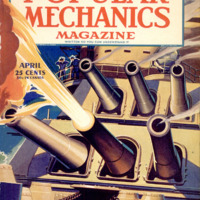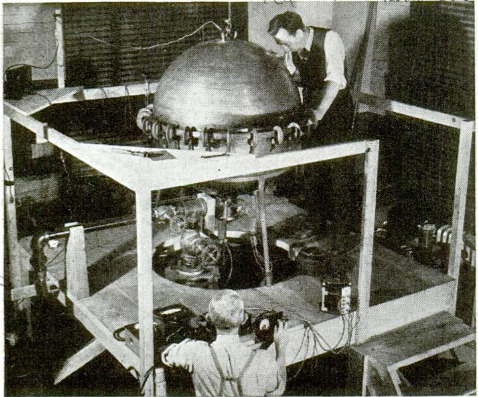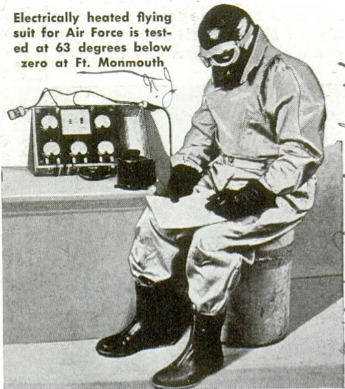UNKNOWN realms of science are being explored so successfully that researchers are getting glimpses of new wonders likely to be of infinite benefit to mankind. All civilization may take a tremendous forward step when radiations almost as powerful as the mysterious cosmic rays emanating from the sun are placed at the disposal of the physicist. And that time is not far away. Work has started on a machine that will whirl electrons up to an energy of 100,000,000 volts, regarded by scientists as approaching the cosmic ray. Strange plants may result from the bombardment of fruit trees, berry bushes and vegetable seed with 1,000,000-volt X-rays. Alteration of chromosomes in living cells of fruits and vegetables, producing changes in color, size, flavor, quality, resistance to disease and other characteristics, is the objective of this effort. Because heavy metal wheels are being spun 1,000 times per second in a vacuum bottle, air transports of the future may operate at altitudes far above those commonly used today, and at much higher speed because air drag is less at the upper levels. The metal wheels are spun in a machine employed in testing rotors of turbo-superchargers, which make possible efficient operation of airplane engines in thin air. In use, the rotors turn at a speed where centrifugal force will make a pound weight on the periphery exert a pull of more than 50 tons. The engineer, seeking to design rotors that will not fly apart under the enormous stresses normally created, or larger ones accidentally applied, makes use of a test machine in which a pound mass exerts a centrifugal pull of over 100 tons. As the metal wheels approach a speed of 1,000 revolutions per second, they literally explode, giving their fragments as much energy as a projectile fired from a small naval gun. Tests are conducted in a vacuum chamber so air resistance will not impede the wheels at extreme speeds. Some molecules wriggle like worms when an alternating current is applied to them, it has been found in the General Electric Research Laboratory. The force required to make them wriggle gives scientists important information regarding their weight and structure. Then, knowing how they are built, new molecules can be designed, with properties to meet specific needs. The importance of this study is found in the fact that these wormlike molecules have many useful applications; artificial silk and rubber are made of them, also many plastics. Not too far in the future are false teeth, so constructed that permanent magnets in upper and lower dentures repel each other. This repelling action forces the dentures against the gums, eliminating the need for adhesives to make the teeth stay in place. Magnetic teeth are made possible by Alnico V, an alloy with about three times the energy of any previously known permanent-magnet material. Shortages of metals have sent the scientist in search of alternate materials. In the field of heat-resisting alloys, study is being made of compositions requiring a minimum of nickel, one of the strategic metals. Already new alloys of aluminum, copper and zinc have been developed. Fighting pilots must be kept warm in high altitudes. As a result of research aimed at development of electrically heated flying suits for America’s aviators, all of us may wear heated clothing a few years hence. Instead of heavy underwear, thick wool suits and huge overcoats, we may don a single lightweight garment that will keep us warm in the coldest weather. This suit would be wired throughout and plugged in on current from a small battery, the electrical system of the automobile or the lighting circuit of home or office. Already many pilots of our war planes are wearing electrically heated suits designed to keep them comfortable in temperature ranging from 60 degrees below zero to 70 degrees above. These flying suits are many pounds lighter than the sheep-skin-lined garments which they replaced. Fully as important to the aviator are the laboratory studies which resulted recently in a new means of measuring the height of clouds from the ground in the daytime. Maurice K. Laufer and Laurence K. Foskett of the National Bureau of Standards found that by projecting the light from a tiny, 1,000-watt mercury lamp and noting with a photo-electric cell - “electric eye” - the “splatter” of light where it hit a cloud, the altitude could be calculated by triangulation. The projector consists of the lamp located at the focus of a 24-inch parabolic mirror having a 10-inch focal length. The narrow beam is projected into the sky at a frequency of 120 flashes per second and the rays scatter when they hit the clouds. The light scattering is detected by the electric eye located at a known distance from the lamp and adjusted for this flash frequency to distinguish the beam from background atmospheric light. The cloud height then is determined by the solution of the right triangle formed by the line of the beam to the clouds, the angle of the electric eye sight upon the clouds and the base line connecting the beam projector and the photo tube. How much sunlight falls on the south side of your house in a year? You prob- ably don’t know, perhaps don’t care, but it’s an important subject of research in the General Electric laboratory. Out of these studies may come recommendations for building homes so that the maximum amount of sunlight may be utilized, or radically different means of heating evolved. One scientist working on the problem employs a house-shaped model attached to a globe. If the model were in proportion to the size of the earth, it would be 1,400 miles high. This model, as well as the globe, is illuminated by a spotlight, which simulates the sun, mounted across the room. This apparatus helps to check calculations of the amount of sunlight which falls on various walls of a building, oriented in different directions, and at different times of the year. Most of us have been annoyed by glare resulting from light striking glass. A long stride has been made toward eliminating that by development of an antiglare treatment. The glass is placed in a large, high vacuum metal globe, then a tiny bit of magnesium fluoride is electrically evaporated, coating each surface with a film 1/300,000 inch thick. After the glass has been coated, the chemical films are hardened by heat and waterproofed. In another field, extremely thin films of synthetic resins, some composed of only 10 to 15 layers of molecules, are proving a useful tool of science. The thinnest films are employed in mounting specimens in the electron microscope, which uses electrons in place of light rays and has magnifying powers of 30,000 diameters or more, many times as powerful as the best light microscopes. Somewhat thicker films are valuable in studying characteristics of the resins. For instance, the effects of ultraviolet light can be shown in a few minutes, whereas hours are required with other methods. Another possible use of the films is that of “beam splitters” in optical instruments after the films have been treated with zinc sulfide. In the instruments, the beam splitter is employed where it is desired to divide a light beam, reflecting part to the side and sending the rest on its original course. Partly silvered mirrors are usually used, but these lose about one-third of the total light; in contrast, only one-twentieth of the light is lost with the films. The thinnest resin films are about 1/2,000,000 inch thick. No one dares to guess how important to man will be the “cosmic ray generator,” devised by Dr. Donald W. Kerst. Promising results already have been obtained with a machine capable of developing only one-fifth of the energy which will be available to scientists using the 100,000,000-volt generator under construction in the General Electric Research Laboratory. In the smaller machine, which Dr. Kerst calls the “Betatron,” electrons - the smallest negatively charged particles - are accelerated to the highest speed ever produced by man-made apparatus. It gives these particles energy corresponding to 20,000,000 volts and also produces X-rays of this power. The magnet of the present machine, now at the University of Illinois, is only five feet long, three feet high and two feet wide - a midget when compared with the apparatus employed in the towering machines previously used for accelerating electrons. A doughnut-shaped glass vacuum tube, between the poles of a large electromagnet, is the heart of the Betatron. Electrons from a hot filament within are whirled around the tube and steadily accelerated by electromagnetic forces until they attain a speed closely approaching 186,000 miles a second, that of light. Magnetically guided, the electrons collide with a metal target. This collision results in production of X-radiation equal in intensity, as determined by ionizing power, to the gamma radiation in a corresponding beam from more than 1,000 grams of radium - more than the world’s existing supply. This smaller machine has produced radiations which have made copper radioactive - a transmuted form of the metal which for a few minutes has some of the characteristics of radium. In addition, electrons have been given sufficient velocity to penetrate an inch of aluminum. Apparently the effective voltage of the Betatron can be increased indefinitely; hence the decision of General Electric scientists to build the larger machine which is expected to impart energy corresponding to 100,000,000 volts to electrons whirling in its vacuum tube at a dizzy speed.
 Popular Mechanics, vol. 77, n. 4, 1942
Popular Mechanics, vol. 77, n. 4, 1942





